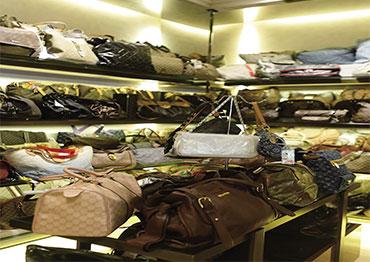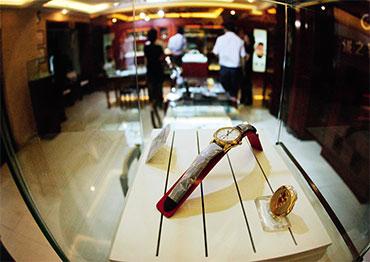“This bag is 99-percent new, 5,599 yuan (US$856) flash sale! After 6 o’clock, you’ll have to pay 5,999 (US$917)! 3, 2, 1! Go get it!” entreats a livestreamer on Douyin, a videosharing platform, demonstrating a pre-owned Louis Vuitton bag from different angles.
In China, the enthusiasm for luxury and designer brands, which began in earnest in 2012, is spilling over to the second-hand market. Statistics from the China Resale Goods Trade Association (CRGTA), an association for second-hand goods, show that since 2016, the annual transaction value of the luxury resale market has surpassed 8 billion yuan (US$1.2b) and is growing over 20 percent year-on-year.
For cash-strapped young consumers, online designer resale platforms lower the threshold for luxury buys, including watches, jewelry, bags and clothing. In 2020, 74 percent of consumers on resale platforms were under 36, with 51 percent between 24 and 36, according to a report by Huaon.com, an industry data provider.
But behind the prosperity lies a chaotic market, mainly due to a dearth of regulation. Thousands of complaints against second-hand goods exchange platforms, including Plum, Ponhu, Goshare2.com and Feiyu, have been filed over fake products, hyped advertisements and shoddy after-sale services. A research report on the luxury resale market released by the University of International Business and Economics (UIBE) in Beijing and Isheyipai, a luxury resale platform, found that between 2017 and 2020 the rate of genuine products sold dropped from 37.6 to 32.9 percent.
“The luxury resale market is sure to expand. For long-term development, a unified industry standard and transparent trade system is needed to improve the overall environment,” said Chang Dalei, general secretary of the CRGTA.
The urgent atmosphere of a hawker market in livestreaming studios for second-hand luxury goods induces panic buying. If consumers are interested in an item, there is no time to hesitate amid the frenetic sales pitches. A studio can sell about 100 luxury items a day, with the price for a single brand item ranging from several thousand yuan to tens of thousands of yuan. But not everyone receives a genuine product.
“I spent more than 3,000 yuan (US$458) on a Dior shoulder bag and 2,000 yuan (US$305) on an Omega watch, and they were both fake,” Liu Yi from Chengdu, Sichuan Province told NewsChina. She said she contacted the platform but the after-sales staff stressed their products were genuine. They did not provide proof of authentication, nor did they agree to a refund.
Liu said she is very familiar with the two brands, so she knew they were fake the instant she received her goods. It will cost more than 1,000 yuan (US$153) if she sends them to be authenticated, and the platform could deny they sold the products in question, or, more likely, refuse to recognize the result. This means once products are sold, the platforms refuse all responsibility.
Even if the items are real, it is common that what you see is not what you get. “I bought a bag the livestreamer claimed was 99- percent new, but when it arrived I found it was a far cry from the demonstrated one. It has obvious creases in the surface and it’s dirty inside, not even 90 percent new,” said a buyer named Yang Yuwei from Jiangxi Province.
It was hard to protect her rights. Since she bought the bag from a livestreaming studio without playback, Yang could not find evidence to show the difference between the exhibited product and the one she received. She tried to get a refund, but the platform refused, saying it does not have an unconditional return policy. The staff suggested she resell the bag on the platform. But the price they offered was less than half what she had just paid, plus they wanted 15 percent commission, adding up to a loss of over 1,000 yuan (US$153).
Many consumers like Yang have made similar complaints on social media and complaint platforms. The report by Isheyipai and UIBE pointed out that since brands do not provide authentication for second-hand products and ordinary consumers lack the ability to distinguish genuine products from fakes, when the transaction is conducted online, it is much easier to sell fakes and consumers have more difficulty protecting their interests.
“The quality of second-hand luxury products varies in the market and it’s particularly risky to buy from livestreaming studios,” said Zhang Mengxia, director of the luxury research center at the UIBE in Beijing.
Second-hand luxury platforms mainly serve as intermediaries and take commission from the sellers. Without regulations already in place, the platforms decide the transaction rules.
Usually, platforms will appraise a product and suggest a price before listing it. After the product is sold, the platform charges 10-20 percent commission and pays the seller the rest. In reality, sellers have little control over the deal and have to swallow price cuts if the platform decides to offer a discount. The longer it takes an item to sell, the more the price drops. If the platform offers coupons to promote sales, the value is deducted from the asking price. Eventually the product might be sold at a much lower price than originally offered without the seller’s consent.
A screenshot provided to NewsChina by one seller shows that his goods were originally priced at 1,700 yuan (US$259), but the platform took more than 600 yuan (US$92) for promotional activities and over 200 yuan (US$31) in commission, leaving him with less than half the agreed-on price.
An employee of an online second-hand luxury goods platform who requested anonymity told NewsChina that the platform handles their own products and those consigned by third-party sellers differently.
“For products they buy themselves the platforms set a bottom line for the sales price, and set a cap on discounts of 30 percent. For sellers, they will randomly reduce the price and stealthily offer buyers lots of [discount] coupons. So it’s common for sellers to get half the original agreed price. By the time the trick is exposed, the deal is done. The seller has no way to get the money back,” they said.
These practices are common on luxury resale platforms, NewsChina discovered. From the appraisal and authentication of products and price estimates to promotion rules and after-sale services, the platforms are in control and bend the rules in their favor to maximize profits.
Wang Chen, a senior appraiser who would not say where he works, told NewsChina that without a unified valuation standard, some appraisers working with platforms might not be able to distinguish the genuine article from counterfeits, and some platforms might not conduct quality assessments of the products properly. “This means the platforms always have the last word and there is a lack of transparency in the trade for both sellers and buyers. So products get valued too high or too low.”
Wang said that in Japan, where the luxury resale market is established, the goods are classified into four grades based on strict standards and the valuations are widely recognized in the industry. In China, products are casually graded as 95-percent, 90-percent or even 98- or 97-percent new by the platforms, without clear distinction or conditions as to what the categories actually mean.
In spite of the chaos, the market for luxury resales has enormous potential. According to the report by Isheyipai and UIBE, sales of second-hand luxury goods account for only 5 percent of the overall market, much lower than the 28 percent in Japan and 31 percent in the US.
By the end of 2019, there were some 4,200 brick-and-mortar shops for second-hand luxury goods and the number increased by 10 percent year-on-year, according to ZhiYan.org, an industry analysis provider. Online platforms are the main channel for luxury resales. Besides platforms specializing in luxury goods, more fashion and ecommerce platforms are jumping in, attracting even more people to consume luxury goods.
But to guide the market along a healthy path, there must be a unified industry standard, noted Chang Dalei.
The CRGTA is drafting industry standards for the online secondhand goods trade that addresses problems like false descriptions of products and sharp practice. The standards are expected to come out this year.
The luxury resale market boom has stimulated the training of appraisers. But the increasing number of training agencies are rarely qualified to carry out the business or able to provide legitimate certificates, said interviewed experts.
Chang said that training and a certain amount of experience are required to become a professional appraiser. It is a job included in China’s official list of professions that have clear requirements for skill, knowledge and assessment.
“Many crash courses claim they can train an appraiser in 3-7 days, but they just teach the most common methods, so what trainees learn is very limited, a far cry from being a professional appraiser,” said Wang, adding that this partly explains why an appraisal for the same product can differ a lot across platforms.
“We can foresee that the luxury resale market will continue to expand. It’s urgent to reinforce supervision and industry regulations to solve problems and risks in this emerging industry and promote its healthy development,” Zhang said.

 Old Version
Old Version

